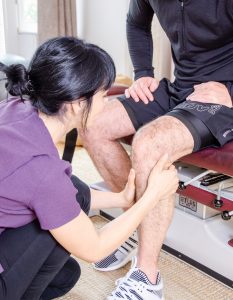 Knee
Knee
Basic Anatomy
The knee is a relatively simple joint, essentially forming a hinge for the lower limb. Knee pain can occur from direct trauma, and repetitive use. It can also radiate from other sources i.e. the hip, or can be due to bad mechanics i.e. the position and movement of the knee.
Conditions treated:
Anterior Cruciate Ligament (ACL) Tear/Sprain - The classic ACL injury occurs when the leg gets twisted inwards as the foot remains planted on the ground, which it's why it's most common with sports. Pain occurs immediately and may be accompanied by swelling. The most serious cases actually rupture the ligament which leaves the knee very unstable and requires surgical repair.
Meniscus tear - Its a small ridge of cartilage around the surface of the lower leg (tibia) which is designed to hold the upper leg (femur) in place. Small tears may heal well but large tears may require surgical intervention. Symptoms include pain, restriction and in more severe cases, joint locking or giving way.
Medial Cruciate Ligament (MCL) tear/sprain - This occurs when force is placed on the outside of the knee forcing it to bend inwards and overstretching the ligaments to the inner aspect of the knee. Pain is the main symptom and may be accompanied by swelling and heat.
Chondromalacia patella (CMP) - The kneecap moves up and down at the front of the knee in a groove, protecting the joint and acting as a point of leverage for the quad muscles. If the kneecap doesn't run smoothly and correctly in this groove, the cartilage covering the back of the kneecap can become damaged and this is CMP. To correct this problem, the cause of the bad kneecap movement needs to be identified and resolved.
Iliotibial Band Syndrome (ITB) - Pain occurs at the outer aspect of the joint and may extend up the thigh. This problem seems to occur in particular with downhill running and with individuals who have flat feet.
Osgood-Schlatters - This is also known as "jumper's knee" as it most commonly occurs in association with impact sports such as basketball or hurdling. Most common in young athletes, symptoms include pain and swelling below the kneecap.
Bursitis - Bursas are protective fluid filled sacs that lie between tendons and the bones or joints they attach onto. With overuse, trauma or incorrect use, these can become inflamed producing localised pain and swelling.
